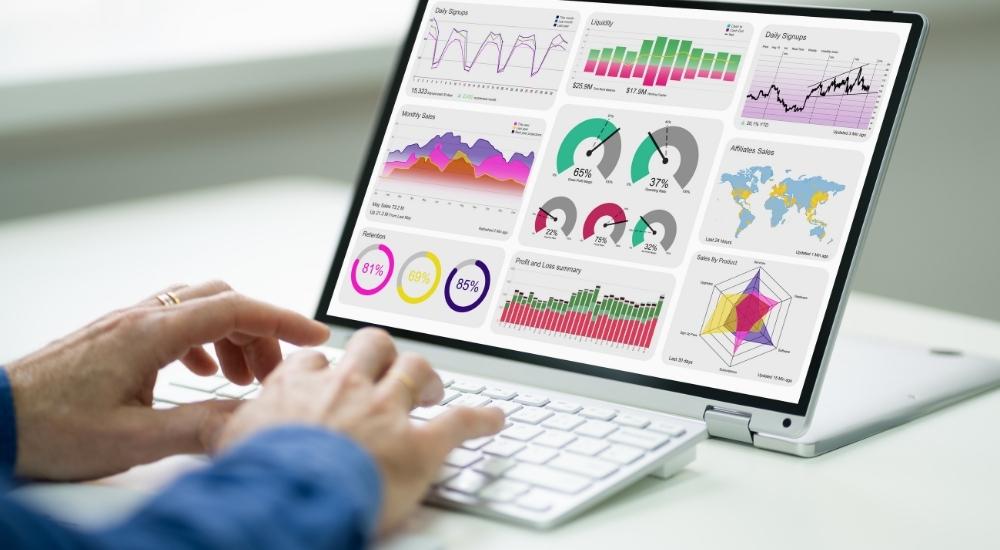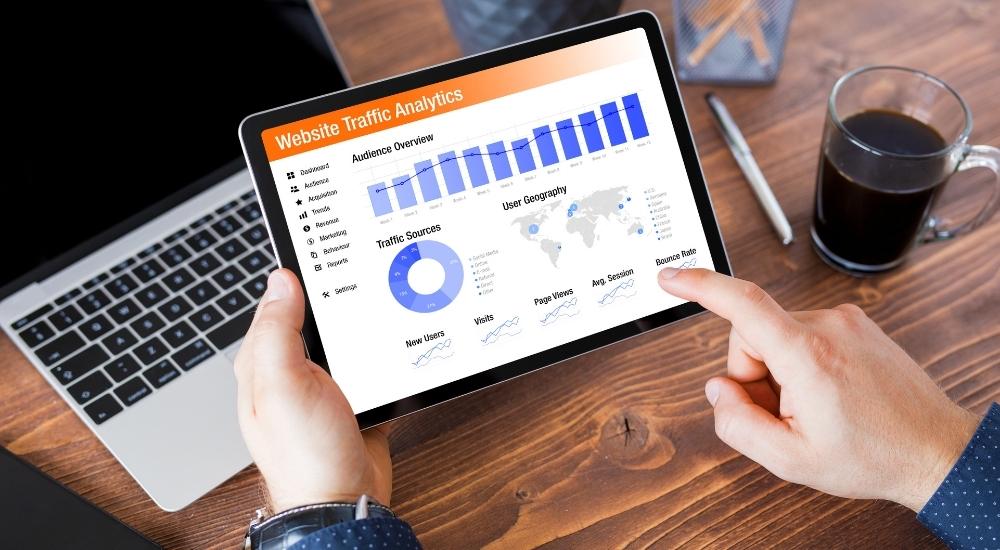eCommerce is on the rise and with good reason. It’s a fast, easy, and affordable way to buy and sell products from anywhere in the world. However, success as an eCommerce business doesn’t just come from having a great product – you also need effective marketing to take your business to the next level. That’s where analytics comes in. In this article, we’ll provide you with everything you need to know about eCommerce analytics – from budgeting and planning to measuring results and making changes as necessary.
What Is eCommerce Analytics?
The activity of discovering, understanding, and communicating data patterns related to online commerce is known as eCommerce analytics. It assists companies in understanding how consumers are behaving, what performance patterns exist, and how much money they’re making.
eCommerce analytics can be used in a number of different ways:
- To identify which products are selling well and why;
- To determine which marketing campaigns are working best;
- To track user behavior across multiple pages on the website;
- To determine whether a particular product is being bought at a high enough rate to justify its production costs.
Companies that want to increase their online sales should use eCommerce analytics in order to better understand how and where customers are spending their money. By understanding what factors are influencing purchase behavior, businesses can tailor marketing efforts accordingly, making more informed product choices, and maximizing profits.
Why Is eCommerce Analytics Important?

Analyze Marketing Data To Drive Business Growth
eCommerce Analytics is a tool that helps you understand your marketing data and use it to drive business growth. By keeping all your data in one place, eCommerce Analytics makes it easy to measure marketing performance and improve decision-making.
You can use eCommerce Analytics to see how effective your campaigns are, identify which channels are working best for you, and track the progress of your customers across different phases of their buying journey. This information can help you make better decisions about how to spend your money and target future opportunities.
In addition, eCommerce Analytics can help you optimize your website for better performance and ensure that users have a positive experience when they visit it. By understanding what works well for you and tailoring your strategies accordingly, you can maximize the benefits of your marketing efforts.
If you’re looking to improve your eCommerce marketing strategy, then eCommerce Analytics is the tool for you. With a comprehensive data analysis platform at your disposal, you can identify where improvements need to be made and get on track to achieving your business goals.
Identify Patterns And Tendencies
eCommerce Analytics is a powerful tool that can help you identify patterns and tendencies in your company. You may see how your business is performing in comparison to other firms in the same sector by viewing your data as a linked system. You may also see how your data is functioning now and in the future.
This information can help you make informed decisions about where to focus your marketing efforts, as well as figure out which products or services are selling best. Additionally, eCommerce Analytics can help you identify any potential problems with your sales or customer retention rates. By using this information wisely, you can keep your business running smoothly and reach its full potential.
Understand How Users Are Interacting

You can use eCommerce analytics to better understand how users are interacting with your website by gathering, managing, and using customer data. By understanding customer behavior and preferences, you can improve your site’s design, content, and marketing efforts.
For example, you can use growth reports to see which sections of your site are engaging more than others. This will help you determine where to focus your time and resources in order to maximize return on investment.
You can also use engagement reports to see the types of content that are most engaging with customers and how best to get it in front of them. And finally, revenue reports can help you identify areas where you’re making more money than you’re spending and direct your efforts there accordingly.
All told, eCommerce analytics is a powerful tool that can help you keep your business afloat by providing valuable insights into customer behavior. It’s important to take advantage of all its capabilities so that you can make the most out of each customer interaction.
Adjust Pricing
Ecommerce analytics can help you optimize your pricing by understanding how price affects purchasing behavior. By understanding the different customer segments and their buying patterns, you can better adjust your prices to meet the needs of each group.
For example, you may find that some customers are more likely to buy a product if it’s cheaper than other products in the same category. On the other hand, others may be willing to pay more for a higher-quality product. By knowing these things, you can adjust your prices accordingly and maximize profits.
In addition to changing your prices, eCommerce analytics also allows you to track customer behavior over time. This information can help you see how changes in pricing or product selection affect sales volumes and revenue growth over time.
Build A Robust Supply Chain
By tracking your inventory levels and shipping rates, eCommerce analytics can help you detect fraud and improve your overall supply chain efficiency. This will help you reduce costs and improve your delivery time to customers A well-functioning supply chain involves coordinated activities between multiple companies that produce and ship products.
Achieving a robust supply chain requires utilizing accurate data collection and analysis tools to monitor your inventory levels, shipping rates, and customer satisfaction levels. By doing so you can detect potential fraud or inefficiencies before they lead to customer dissatisfaction.
What Are The Types of eCommerce Analytics?

ECommerce analytics can help you track and analyze your online sales performance. There are a variety of different types of eCommerce analytics, each with its own benefits and drawbacks. Here is a breakdown of the most common types:
Web Server Logs
Web server logs are a type of analytics that use log files to track page views, unique visitors, and other activity on your website. This data can help you identify areas of your website that are performing poorly and what might be causing them.
One of the most important things to keep in mind when using web server logs is to remember that they’re only as good as the data that’s being recorded in them. If you don’t have accurate information about how people are actually using your website, then you won’t be able to make any useful conclusions from your logs.
Another thing to keep in mind is that web server logs aren’t always easy to access or use. They may require special software or a specialized understanding of how websites work. However, if you’re looking for an effective way to track the performance of your website, then web server logs could be a good option for you.
Abandoned Shopping Cart Sessions
Ecommerce platforms like Shopify allow you to track the number of abandoned shopping carts in order to make changes to your sales process or product offerings.
If too many shoppers abandon their carts, it can indicate that your sales process or product offerings are not meeting their needs. This can lead to decreased customer engagement and ultimately lost profits.
One way to combat this is by making sure that you’re providing a high-quality experience from start to finish. This means ensuring that your website is easy to navigate, that your products are accurately described, and that you’re responding quickly to customer inquiries. Additionally, it can be helpful to offer discounts or other incentives for shoppers who complete their purchase within a certain timeframe.
By taking these steps, you’ll be able to reduce the number of abandoned shopping carts and increase your profits in the long run.
Search Engine Ranking

Search engine ranking is one of the most important factors when it comes to online visibility. It determines where your website appears on a user’s search engine results page (SERP), and how well they are likely to be able to find what they’re looking for.
Google has been the dominant player in the search engine market for over 20 years, and its algorithms are constantly changing in order to rank websites higher. This means that if you want your website to be ranked high, then you need to make sure that your marketing campaigns are effective at driving traffic to it.
One way to measure this is by tracking changes in search engine rankings. This can help you determine how effective specific marketing campaigns have been in driving traffic to your store. By analyzing these changes over time, you can identify which strategies are working best and adjust them accordingly. This way, you can make sure that your website stays visible and provides users with the information they’re looking for.
Revenue
Revenue is one of the most important factors in eCommerce, as it can tell you a lot about your business. By tracking your revenue over time, eCommerce analytics can help you determine whether your customers are spending more money than they were in previous months or years. This information can help you make decisions about changes you might need to make to your website or marketing strategy.
One of the most common ways to track revenue is by using Google Analytics. This free tool allows you to track everything from pageviews to conversion rates, and it gives you detailed insights into how customers are interacting with your website. By understanding where and how people are clicking on your ads, for example, you can decide which ones to target next.
Social Media Analytics

Monitoring social media can help you understand how your customers are discussing your products and services. By monitoring your Facebook, Twitter, and other social media accounts, you can gain insights into what topics are being discussed the most, as well as how people are interacting with your products. This information can help you make better decisions about what to post on your social media pages and how to market them.
Some of the most common methods for monitoring social media include sentiment analysis (analyzing whether positive or negative sentiment is spreading), keyword research (determining which keywords are being used most often), and demographic analysis (finding out which demographics are using your product the most). By using these tools, you can make sure that your posts are hitting the right target audience and that you’re providing the best possible service to your customers.
Website Speed
If your website is taking too long to load, customers may abandon their carts or leave negative reviews. By tracking the time it takes to load different parts of your website, you can make improvements.
One of the most important things to track is the response time of your website’s various pages. This includes everything from the homepage to the individual product pages. By knowing how long it takes for each page to load, you can prioritize which ones need attention and make necessary adjustments.
You can also use server-side rendering (SSR) to speed up your webpages by caching them on the server before they’re sent to the browser. This results in a faster loading experience for users, because no additional data is sent across the network. SSR also saves you money by reducing bandwidth usage and improving user experience with high latency networks.
Device Tracking
Device tracking is a relatively new technology that allows you to understand which devices are visiting your website and how long they spend on each page. This information can then be used to better target marketing campaigns specifically designed for mobile users or desktop browsers.
There are a number of different tools that you can use to track device visits, but the most popular one is Google Analytics. This tool allows you to see which pages are being visited the most and how long people stay on each page. By understanding this data, you can then create targeted marketing campaigns accordingly.
Another great tool for device tracking is Adobe SiteCatalyst. It allows you to track all the activity on your website – from clicks and form submissions to social media engagement and eCommerce transactions. This information can then be used to improve your site’s performance and optimize its design for maximum efficiency. Server-side rendering (SSR).
Best Practices to Conduct eCommerce Analytics

eCommerce analytics can help you track and analyze your customers’ behavior on your website. This information can help you optimize your site for better conversions, improve customer retention rates, and more.
There are a few important things to keep in mind when conducting eCommerce analytics:
Understand Who Your Target Audience Is
To conduct effective ECommerce analytics, it’s important to first understand who your target audience is. This can be done by doing some research to find out what they want and how they behave online. .
Surveys and interviews are one of the best ways to get information about your target audience’s preferences and needs. They’re also a quick way to gather data, which means you can get a more accurate picture of what they want than if you were to rely on intuition or gut feeling.
Surveys are usually conducted online, where you ask respondents a series of questions about their opinions on different topics. This allows you to get an overall view of how people feel about certain issues, and it gives you an idea of what kinds of products or services they would be interested in. Interviews are similar in that they allow you to ask people questions in person, but they’re also used to gain deeper insights into specific topics. This is useful because it lets you explore issues from different angles, and it allows you to interrogate respondents more fully about their opinions on things.
Track All Data
Data is everywhere, and it’s becoming increasingly important for businesses to track it all in order to make informed decisions.
At first, most data will be irrelevant. But as analysts get more insights into user behavior, they’ll begin to see patterns that merit further investigation. This is why tracking data is so important; you don’t want to miss any opportunities because you didn’t have the data, to begin with.
There are a number of different ways that you can track data, but the most efficient way is probably through dashboards and Reports. This will allow you to see trends and patterns at a glance, which can help you make better decisions faster. Plus, it’s always helpful to have up-to-date information so that you can answer questions quickly and effectively.
Record And Analyze Data Properly

Data is a key asset for any business, and it’s important to make sure that it’s properly recorded and analyzed so that it can be used effectively for decision-making.
If you’re not collecting data, you’re not going to be able to make the informed decisions that are necessary for success. Data collection should be a priority for every business, regardless of its size or sector. You should make sure that data is accurate and up-to-date.
Once data is collected, it needs to be analyzed in order to determine what actions should be taken next. This process can involve using statistics, trend analysis, and other analytical techniques in order to identify patterns and trends. It can also help identify potential areas of growth or decline for your business. By ensuring that all data is collected and analyzed correctly, you’ll be able to make informed decisions that will help your business grow!
Stay Up-To-Date With The Latest Technology
There are a number of different ways in which technology can be used for data collection and analysis. You can use online tools or software applications in order to capture data quickly and easily. You can also use electronic forms or surveys in order to collect data from respondents. By using the latest technology, you’ll be able to ensure that your data is accurate and up-to-date.
If you’re not using the latest technology to collect and analyze your data, you risk falling behind the competition. By using the latest technology available, you’ll be able to increase your overall efficiency and ensure that your business is up-to-date with the latest trends.
Constantly Conduct Analysis

Conduct regular analysis of your traffic sources and conversion rates to identify any trends. This information can help you identify areas of your website that are performing better or worse than expected.
Use eCommerce analytics to track which elements of your website are most popular with customers. This information can help you decide which features to focus on for future development and optimization efforts.
Monitor site performance metrics such as page views, average time on page (ATOP), and bounce rates over time to see how they change based on different marketing campaigns or product variations. This data can help you determine whether certain marketing initiatives are having the desired effect or if there is a need for additional improvements in your marketing strategy.
Keep a close eye on customer behavior to see how customers interact with your website and what leads them to make purchase decisions. This data can help you improve the design of your content and product pages, as well as tailor customer service responses based on individual needs.
Compare With Your Competitors
Comparing your results against those of your competitors is an important way to identify which strategies are working best for them and how you can improve your own performance.
One simple way to do this is to analyze your website traffic statistics. This will give you an idea of which areas of your website are generating the most interest from potential customers. You can then use that information to focus your marketing efforts on those areas, or even develop new strategies specifically designed to appeal to that demographic.
Another useful measure of success is customer satisfaction ratings. By understanding what customers think about your products and services, you can make sure that you’re providing the best possible experience possible. With this information in hand, you can also start to identify any problems that need to be fixed and make changes accordingly.
There are a variety of other metrics that you can use in order to compare your performance against that of your competitors. The key is to find out what’s important to them and how you can be better positioned to capture their attention.
Track And Analyze Customer Behavior Across Different Channels
Tracking and analyzing customer behavior across different channels is essential for businesses to remain competitive. By understanding where customers are spending their time and what they’re saying about your product or service, you can make adjustments that will improve your overall business performance.
There are multiple ways to track customer behavior across different channels:
- Online tracking. This option involves using tools like Google Analytics or Mixpanel to capture information on how users are interacting with your website. This data can help you understand how people are finding and navigating through your content, as well as how they’re using the features and functions of your site.
- Social media tracking. Monitoring social media platforms like Twitter, Facebook or Instagram can help you see which posts are being shared the most and why. This information can help you identify which posts resonate with your target audience and determine the best way to present them on your site or social media account.
- Mobile tracking. Using apps like AppData or Sensor Tower, you can track where customers are coming from and what devices they’re using to access your site or app. This information can help you optimize the layout, design, and presentation of your content in order to make it more user-friendly.
- Offline tracking. Tracking customer activity in physical stores, at panels, or during other events is also an effective way of gaining insights into customer behavior. By understanding where people are
Visualize Your Data

There are a number of different ways that you can use data visualization tools to help you understand your data and make more informed decisions.
One of the most common ways that people use data visualization tools is to visualize data in charts and graphs. This can help you to see patterns, trends, and correlations in your data that you may never have noticed before. It can also help you to understand how different factors affect each other.
You can also use data visualization tools to create maps and graphs that show geographic information or network data. This can help you see how different areas are related or how various nodes within a network are connected.
Finally, data visualization tools can be used to create diagrams and models that illustrate complex concepts or processes. This can help you to understand the structure and workings of your system better, as well as make predictions about future behavior.
Best eCommerce Analytics Tools You Shoud Use
It’s always useful to keep tabs on the performance of your eCommerce website, and there are a number of different tools that can help you do just that. Here are nine of the best eCommerce analytics tools:
1. Google Analytics
Google Analytics is one of the most well-known and popular eCommerce analytics tools available. It allows you to track a variety of information about your website’s traffic, including pageviews, sessions, and conversions.
One of the biggest benefits of using Google Analytics is that it’s free to use. This means that you can get started with it without spending a lot of money or time getting setup. Additionally, Google Analytics provides a wealth of data that can help you track your progress and improve your website’s performance.
One downside to Google Analytics is that it’s not as granular as some other eCommerce analytics tools. For example, it doesn’t provide as much detail about individual pageviews or conversions. However, this isn’t necessarily a bad thing; instead, it makes Google Analytics more general purpose and versatile. Overall, Google Analytics is an excellent tool for tracking your website’s traffic statistics.
2. Kissmetrics
Kissmetrics is another great option for tracking web traffic and performance. It offers detailed reports on how users interact with your website, including things like click-through rates, time on page, and other information.
This data can help you identify which sections of your website are performing the best and where users are clicking or scrolling most often. This information can also help you improve your website’s design and layout accordingly. Additionally, Kissmetrics provides detailed analysis of how users are interacting with your content, so you can learn what works well and what needs to be improved.
3. Optimizely
Optimizely is a powerful tool that can help you optimize your website’s design and marketing efforts. It allows you to test different variations of your content or ads in order to find those that work best. This is an important tool for improving your website’s performance, as it helps you to identify which aspects of your design or marketing are working well and which ones need improvement.
By using Optimizely, you can also measure the impact that changes to your content or ads have on your website’s traffic and conversion rates. This can help you to make informed decisions about how best to use these resources, so that you can achieve the outcomes that you desire.
4. Hotjar
Hotjar is a website tracking tool that lets you track user interactions with your website in real time. This can be extremely valuable for understanding how users are interacting with your pages (including errors), and it can help you to improve your website’s usability.
One of the main benefits of using Hotjar is that it makes it easy to see how users are clicking on links, scrolling down pages, and filling out forms. You can also see how long they spend on each page, and which elements of the page are most popular. This information can help you to identify areas where you need to make changes or improvements, and it can also provide you with insights into how your website is performing overall.
Hotjar is free to use, and it doesn’t require any registration or sign-up procedures. It works with both desktop and mobile browsers, so there’s no need to worry about compatibility issues. In addition, Hotjar provides detailed reports that are easy to understand and use. So whether you’re looking for a simple way to track user behavior on your website or you’re looking for an more comprehensive solution that provides loads of valuable data, Hotjar should definitely be at the top of your list!
5. Crazy Egg
Crazy Egg is a tool that monitors user activity on websites so you can understand how people are clicking through your pages and what kinds of things draw their attention the most. This information can help you optimize your website for better performance and increase your website’s conversion rate.
Crazy Egg is free to use, and it works with any website. You simply add a code to your website’s header or footer, and Crazy Egg will start tracking all the activity on your site. It will also record the number of visitors who clicked on different parts of your website, as well as how long they lasted on each page. This information can help you improve your website design and marketing strategies, by understanding which areas are most important to users and what kind of content really catches their attention.
Wrap Up
By reading this post, you have learned that eCommerce analytics is a necessary part of your business. The formula for success doesn’t change just because the time for it does. To make decision-making easy, keep in mind the factors we have discussed above and select the best eCommerce analytics tool or suite accordingly. A good set of analytics can save you thousands of dollars in expenses while helping you improve your sales performance.
Beside constantly monitoring your eCommerce analytics, it is of paramount importance to make adjustments to your sites accordingly on the spot. If you don’t get a grasp of how to do that, Tigren is here with assistance. Our eCommerce experts will go over your site, compile information, analyze and help you enhance your site in the way that comply with your business goal.
Contact us via [email protected] today!

Read more:

